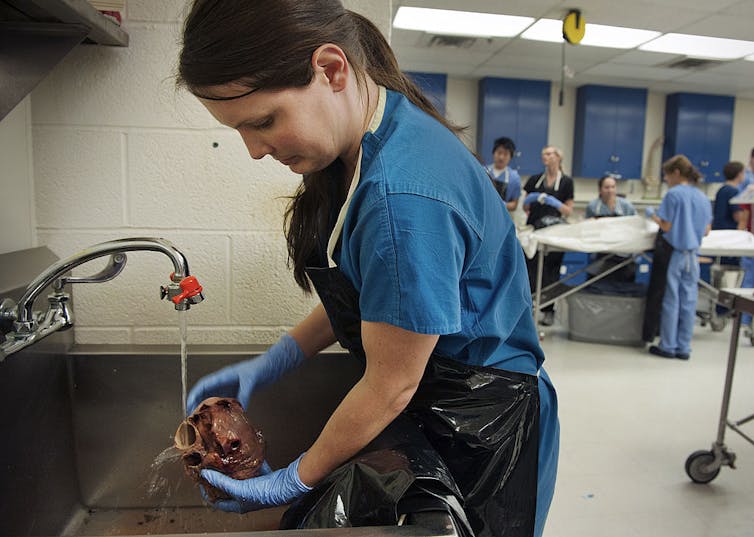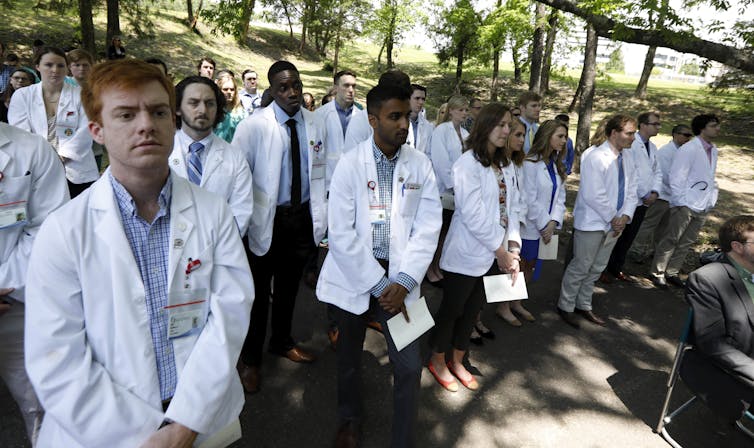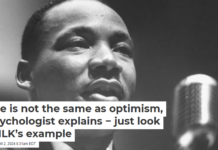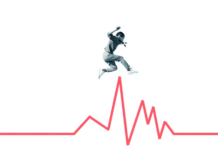

Amy Lawton, Brandeis University
Six people were charged on June 14, 2023, with buying and selling human remains stolen from the Harvard Medical School morgue and from an Arkansas mortuary. The macabre story made national headlines, particularly the indictment of Cedric Lodge: a morgue manager at Harvard from 1995 until earlier this year.
As a scholar in the sociology of religion, my research explores practices related to whole-body donation in medical schools across the United States. While these accusations against Lodge are deeply troubling, they are an aberration: Medical school communities go to incredible lengths to respect and honor the people who donate their bodies to science.
Much of this happens behind closed doors. The serious scientific work of anatomical study is undergirded by practices that promote the donors’ dignity, including memorial ceremonies to honor their gift. I conducted a census of allopathic medical schools – schools that grant the M.D. degree – and analyzed recordings of 60 donor memorial ceremonies, as well as other materials.
Foundation of learning
Despite advances made in technology, including virtual reality and 3D anatomy software, dissecting a real human body is generally considered irreplaceable in Western medical education. Substitutions result in less effective instruction, leading to lower scores on practical and written examinations. One benefit is that students who learn from dissection see normal bodies, with diversity, variations and imperfections that would not be evident on models. Faculty views donor bodies as essential because they are always accurate and up to date, which cannot always be said about books or software.
In the U.S., medical schools accept bodies from donors and next of kin. A minority of institutions accept unclaimed bodies, but their use is controversial.
Bodies’ importance goes beyond their effectiveness as a teaching tool. Anatomy lab marks the students’ initiation into the medical profession. It teaches not only anatomy but the value of the human person, professionalism, ethics and clinical skills such as diagnosis.

From day one, medical students studying gross anatomy are encouraged to think of the donor body as their “first patient,” someone for whom they will care and from whom they will learn. Medical students are responsible for preserving the body, performing dissections correctly so as not to cause unnecessary mutilation, and speaking of the body and the donor respectfully.
Students work in teams, each of which is usually responsible for dissecting one body. Many also feel a sense of responsibility toward their donors – a duty to learn as much as they can, taking full advantage of the gift they have been given.
Reflection and respect
At the end of the semester, students say goodbye to the donors. My research found that more than nine out of 10 allopathic medical schools mark this occasion with a memorial ceremony. Ceremonies also take place at schools for other branches of health care, such as osteopathy and physical therapy. Wherever students learn from body donors, they gather together to express their gratitude for a gift that can never be reciprocated.
Some ceremonies are conducted before an audience that includes the friends and families of all body donors used that year. Some are open to the medical school community, and others are for the students alone. For many, these donors have played a transformative role in their lives. It is common to hear students refer to their donors as a friend or mentor.
At the 2018 University of Iowa ceremony, a student reflected: “I know her hands, her feet, what parts of her may have ached towards the end of life, which organs let her down. I spent countless hours as her pupil. She taught me things about life that no living person ever could. When I was confused and needed time to think, she was patient. My donor entrusted me with the intimate gift of her body to learn about the topics that make my heart race.”
Learning in the anatomy lab and participating in a donor memorial ceremony have something important in common. Both experiences stand apart from everyday life, making them, in a sense, sacred. These ceremonies set aside a special time and space for reflection and remembrance – time and space that busy medical students do not usually have.
Unlike most memorial services, these students have no personal memories of the deceased. In fact, some are not even told their donor’s first name, which is often concealed to preserve privacy.
Yet they know at least one fact: This person cared about medicine and other people’s health. Students reflect on how generous and principled the donors must have been – as well as their families, who were willing to carry out loved ones’ wishes in their time of grief. Though students did not witness donors’ lives, they can still celebrate and honor them.
A student at the University of Cincinnati’s 2019 service shared: “I am overwhelmed with respect and gratitude for all our donors. … As we gather here today, let’s remember the legacy that all of these donors and family members have left in all of us, and celebrate the legacy that they continue to forge even after death.”

A donor body’s gift cannot be “paid back,” but medical students can try to pay it forward. Many describe ways they will try to serve others, as the donor did. Some doctors-to-be express a sense that the donors will forever guide their hands.
There is no foolproof way to prevent bad actors in any institution. Yet research into donor memorial ceremonies shows that no one takes the gift of body donation more seriously than the recipients.
Amy Lawton, Research Manager, Chaplaincy Innovation Lab, Brandeis University
This article is republished from The Conversation under a Creative Commons license. Read the original article.



















